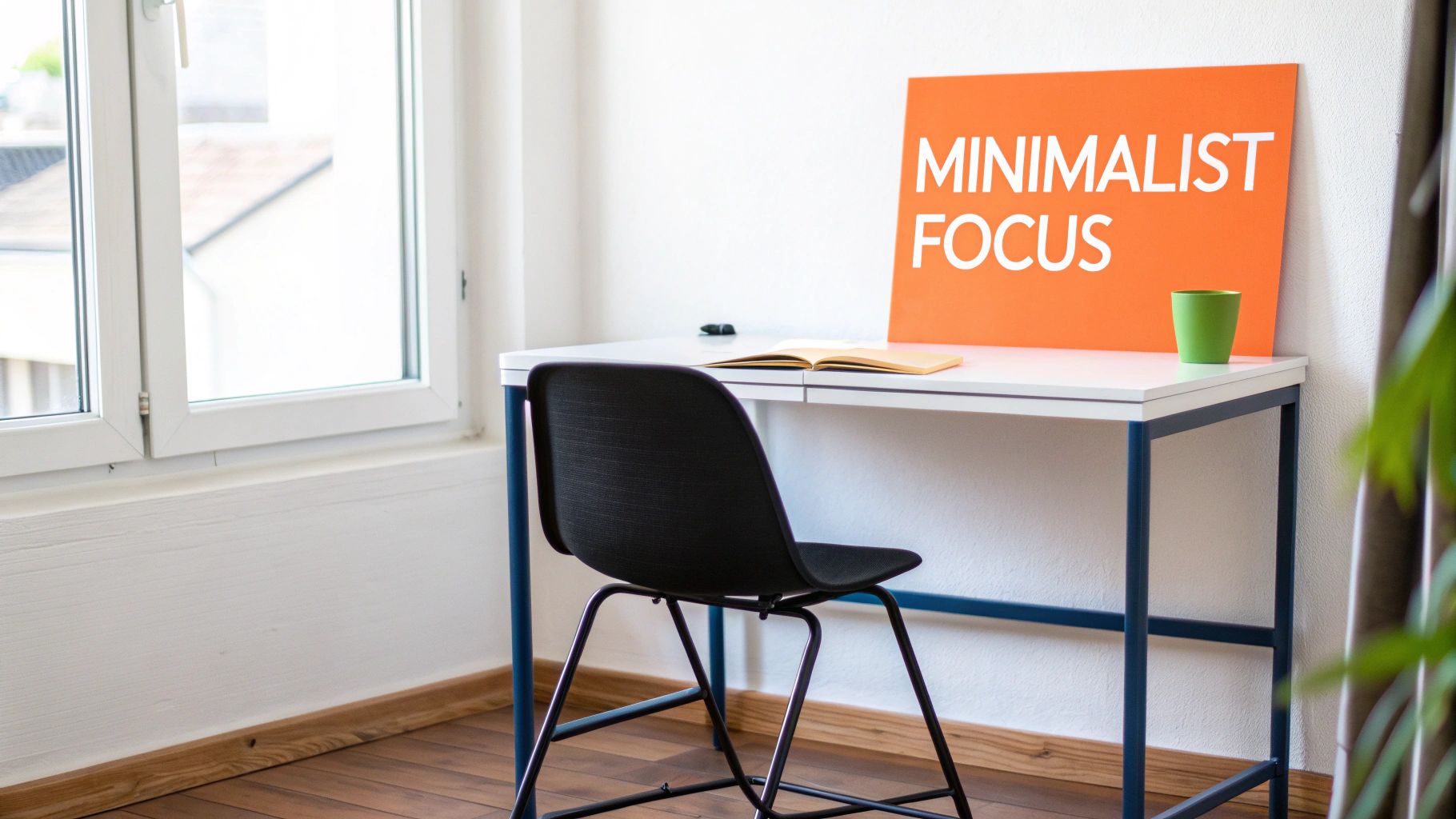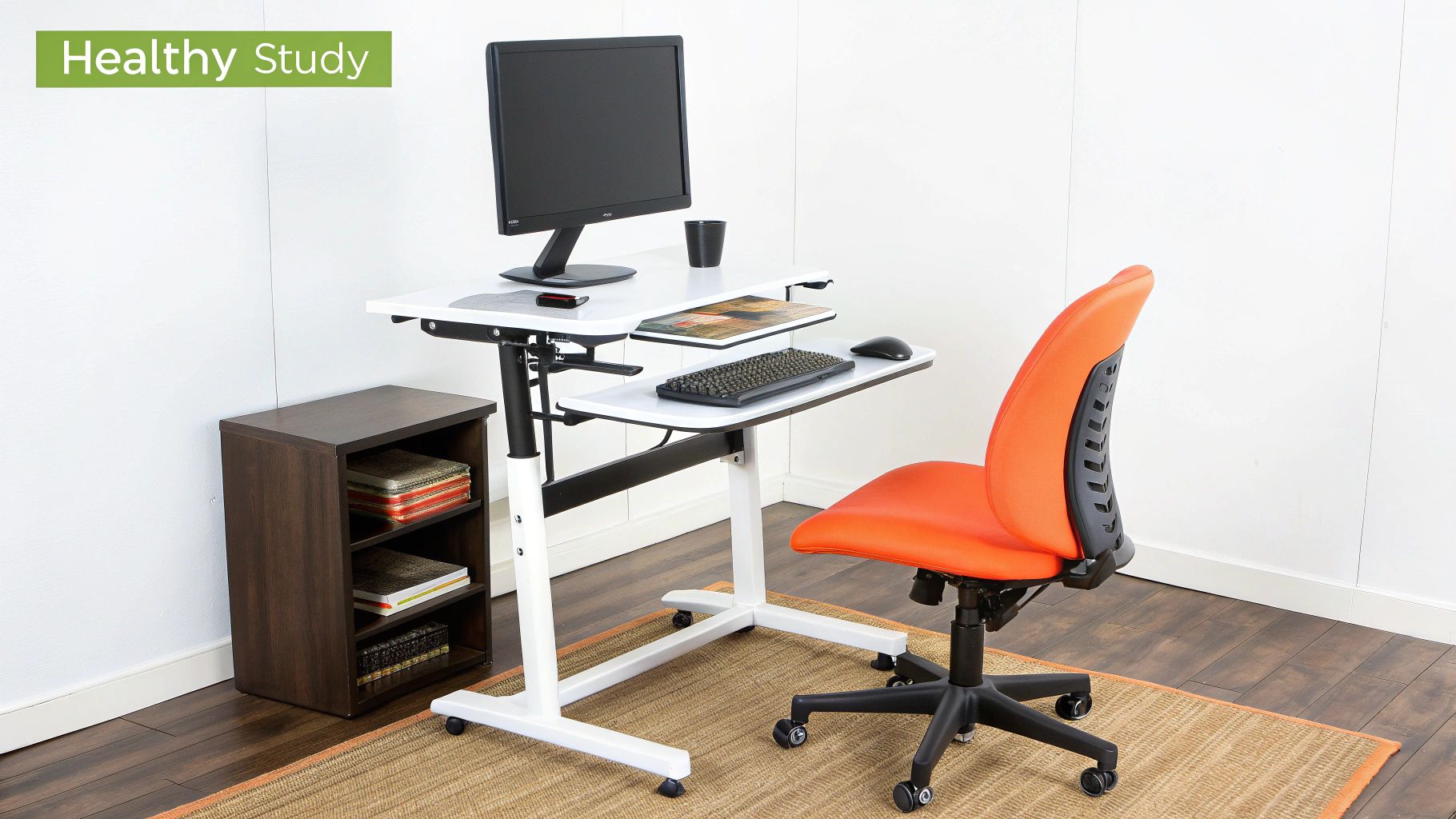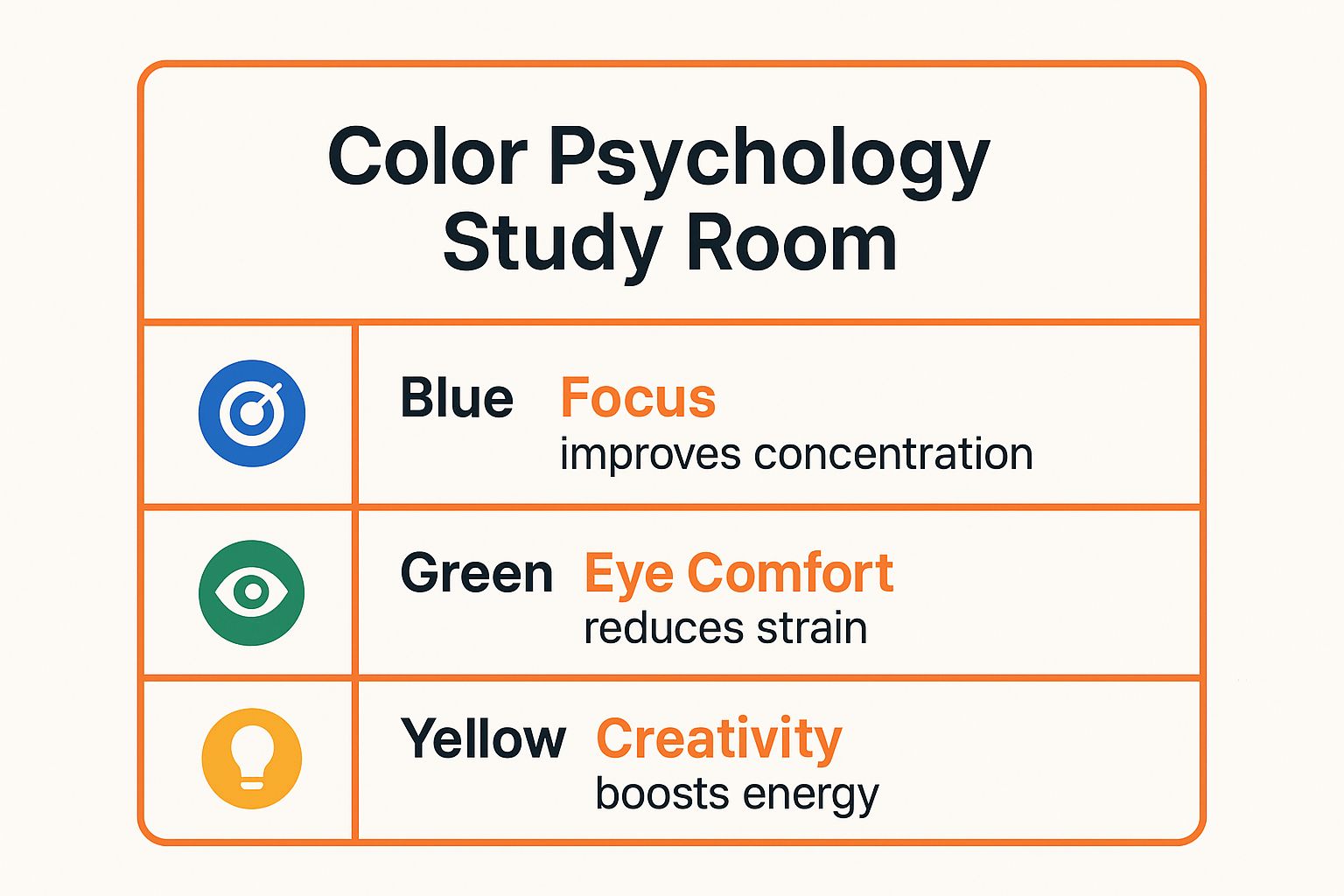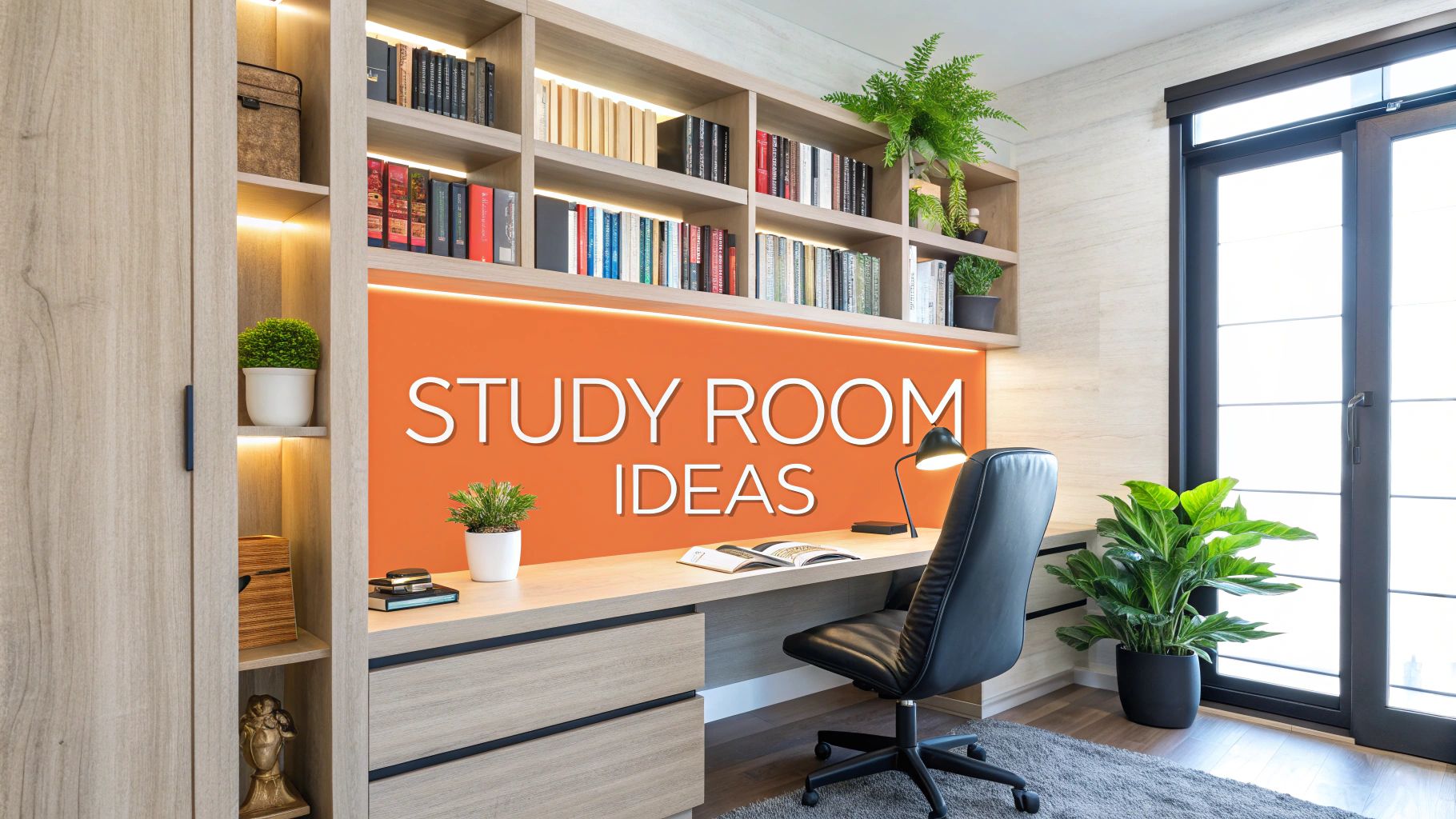A well-designed study room is more than just a place to work; it's a personalised environment engineered for focus, creativity, and success. The right layout, colour scheme, and furniture can transform a simple corner into a powerhouse of productivity. Whether you're a student tackling exams or a professional working from home, your study space should actively support your goals and well-being. At the heart of any productive study sanctuary is a well-chosen work surface, such as selecting a functional study desk that fits both your space and your workflow.
This guide moves beyond generic advice to explore nine distinct study room design approaches, offering actionable insights to help you create a space that not only looks great but also enhances your concentration and efficiency. We'll delve into everything from the science-backed principles of ergonomics to the calming influence of nature, ensuring you find the perfect blueprint to match your unique needs and personal style. Let's move beyond the ordinary and build a study room that truly works for you, fostering an atmosphere where you can thrive.
1. The Minimalist Study Room: Focus Through Simplicity
A minimalist study room design strips away distractions to create an environment of pure focus. This approach centres on functionality and simplicity, using only the essential elements needed for productive work. The philosophy is simple: a clear space leads to a clear mind, making it an ideal choice for students and professionals who are easily overwhelmed by visual clutter.

Inspired by Scandinavian and Japanese interior design, this style transforms your study into a serene sanctuary. Think clean lines, neutral colour palettes (whites, greys, and beiges), and an absence of unnecessary ornamentation. The goal isn't to create a cold or empty room, but rather a purposeful one where every item has a specific function and a designated place.
How to Achieve a Minimalist Study Space
Creating this focused environment involves intentional choices. Quality is always prioritised over quantity, from the chair you sit on to the pen you use.
- Embrace Built-in Storage: Use integrated shelving or cabinets to keep supplies out of sight. A clean desk surface is a cornerstone of minimalist study room design.
- Choose Multifunctional Furniture: A desk with built-in drawers or a storage ottoman can serve multiple purposes, reducing the need for extra pieces.
- Utilise Vertical Space: Install wall-mounted shelves or organisers to draw the eye upward and keep the floor clear, creating a sense of openness.
- Maintain a "One In, One Out" Rule: For every new item you bring into the study, remove an old one. This prevents the gradual accumulation of clutter.
2. The Biophilic Study Room: Boosting Brainpower with Nature
A biophilic study room design harnesses our innate connection to nature to create an environment that enhances well-being and cognitive function. This approach is built on the "biophilia hypothesis," which suggests humans have a deep-seated need to connect with the natural world. By integrating natural elements into your study, you can reduce stress, improve focus, and boost creativity, making it perfect for long hours of learning or deep work.

Inspired by the restorative qualities of the outdoors, this design concept goes beyond just adding a few pot plants. It's about creating a holistic, multi-sensory experience that mimics a natural setting. Think natural light, organic materials, earthy colour palettes, and even the subtle sounds of nature. This style is gaining popularity in corporate spaces like Google's offices and educational institutions, proving its effectiveness in fostering productivity and mental clarity. This trend aligns with a broader movement in design, and you can learn more about how biophilia fits into modern Australian interior design trends.
How to Cultivate a Biophilic Study Space
Bringing the outdoors in involves more than just aesthetics; it's about creating a living, breathing workspace that supports you. Every element should contribute to a sense of calm and connection.
- Introduce Living Plants: Start with low-maintenance options like snake plants, pothos, or ZZ plants. Place them on shelves, your desk, or in hanging planters to create layers of greenery.
- Use Natural Materials: Opt for a desk or shelving made from natural wood like oak or bamboo. Incorporate textures like linen, wool, or jute in your rug and cushions.
- Maximise Natural Light: Position your desk near a window to soak up daylight, which helps regulate your body's natural rhythms and improves alertness.
- Choose an Earthy Colour Palette: Paint your walls in soft greens, warm beiges, or muted blues to create a calming backdrop that evokes a natural landscape.
3. The Ergonomic Study Room: Health and Productivity by Design
An ergonomic study room design is a scientifically-backed approach that centres on your physical well-being to boost productivity. This methodology focuses on creating a workspace that adapts to your body, not the other way around. By prioritising comfort and efficiency, it aims to reduce physical strain, prevent injuries, and enhance concentration during long study sessions. A well-organised ergonomic setup ensures that every element, from your chair to your monitor, supports a healthy posture.

Pioneered by researchers and popularised by companies like Herman Miller and Steelcase, this approach transforms your study from a potential source of back pain into a high-performance environment. The core principle is that a comfortable body allows the mind to work without distraction. This study room design is ideal for anyone spending several hours a day at their desk, as it directly invests in long-term health and sustained focus. You can learn more about the benefits of ergonomic furniture and how it contributes to a better work-life balance.
How to Achieve an Ergonomic Study Space
Creating this supportive environment involves careful adjustments to your furniture and layout. The goal is to achieve a neutral body position where joints are naturally aligned.
- Adjust Your Chair and Desk: Ensure your feet are flat on the floor or on a footrest, with your knees at a 90-degree angle. Your arms should also rest at a 90-degree angle on the desk or armrests.
- Position Your Monitor Correctly: The top of your screen should be at or slightly below eye level, and about 50-65 cm (20-26 inches) away from your face to prevent eye and neck strain.
- Organise Your Workspace: Keep frequently used items like notebooks, pens, and your mouse within easy arm’s reach to avoid stretching or awkward movements.
- Implement Proper Lighting: Use an adjustable LED desk lamp to illuminate your work area directly, reducing glare and preventing eye fatigue.
4. Tech-Integrated Smart Study Room
A tech-integrated smart study room design leverages digital technology and automation to create a highly efficient and responsive learning environment. This modern approach seamlessly incorporates smart systems and IoT (Internet of Things) devices to streamline tasks, enhance focus, and adapt to your unique study habits. The core idea is to build a workspace that works for you, automating lighting, climate, and digital tools for maximum convenience.
Inspired by the connected ecosystems popularised by Google Nest and Amazon Alexa, this style turns your study room into a command centre for productivity. Imagine lights that adjust their colour temperature based on the time of day to reduce eye strain, or a smart assistant that can set timers and read articles aloud. This study room design is perfect for tech-savvy students and professionals who want to optimise their workflow through cutting-edge innovation.
How to Create a Smart Study Space
Building a smart study room involves integrating technology to enhance, not distract from, your work. The focus is on creating automated routines that support deep concentration and efficiency.
- Automate Your Environment: Start with smart lighting like Philips Hue to schedule cool, bright light for focus sessions and warmer tones for evening reading. Add a smart plug to your fan or heater for automated climate control.
- Centralise Control with a Hub: Use a smart speaker or display (like Google Nest Hub or Amazon Echo Show) as a central point to manage devices, set voice-activated study timers, and get quick answers without picking up your phone.
- Prioritise Connectivity and Power: Ensure you have a robust, high-speed internet connection to support all your devices. Invest in a quality surge protector and an effective cable management system to keep your desk organised and safe. For more tips on keeping wires tidy, you can learn more about under-desk cable management solutions.
- Integrate Digital Learning Tools: Utilise a large monitor or a dual-screen setup for improved multitasking. A digital note-taking device, like a smart tablet, can help you digitise and organise your notes effortlessly.
5. The Colour Psychology Study Room: Boost Performance with Hues
A colour psychology study room design strategically uses the psychological impact of different colours to enhance mood, concentration, and cognitive function. This approach moves beyond simple aesthetics, treating colour as a powerful tool to create an environment optimised for specific learning goals. The core idea is that different hues can evoke distinct emotional and mental responses, helping to tailor your space for either focused analytical work or expansive creative thinking.
Popularised by theorists like Faber Birren and modern environmental psychology researchers, this method is seen in the intentional colour schemes of innovative companies like Google and in carefully planned university libraries. It allows you to engineer your study room design to support your unique needs, whether that means using calming greens to reduce eye strain during long reading sessions or energetic yellows to spark new ideas.
How to Implement Colour Psychology in Your Study
Applying colour psychology involves more than just picking a favourite shade; it’s about deliberate and balanced application to achieve a desired outcome.
- Choose a Dominant Colour for Your Goal: Use calming blue on walls for tasks requiring deep concentration and logic. For spaces meant to reduce stress and eye fatigue, green is an ideal choice as a primary or secondary colour.
- Use Accent Colours for Specific Tasks: Incorporate pops of yellow through desk accessories or a pinboard to stimulate creativity and energy. Avoid using overwhelming bright colours, like red, in large amounts, as they can cause agitation.
- Test Colours in Your Space: Paint small test patches on your walls to see how colours look in different lighting conditions throughout the day. What appears subtle in the morning might feel intense under artificial light at night.
For a quick reference on which colours to prioritise, the summary box below highlights the core benefits of the most effective study room hues.

These key takeaways show how a balanced combination of blue for focus, green for comfort, and yellow for creativity can build a highly effective study environment. You can learn more about how to apply these principles from detailed guides on colour psychology in study rooms to perfect your space.
6. The Flexible Multi-Purpose Study Space: Adaptability by Design
A flexible multi-purpose study space is a versatile design that allows a single room to serve multiple functions. Through moveable furniture, modular components, and adaptable layouts, this concept maximises space efficiency, catering to various activities throughout the day, from focused work to collaborative projects or even relaxation. This approach is perfect for smaller homes, apartments, or any room that needs to wear multiple hats.
Inspired by the dynamic nature of modern co-working spaces like WeWork and the clever efficiency of Japanese micro-apartments, this study room design is all about intelligent transformation. The room can shift from a quiet solo study nook in the morning to a creative hub in the afternoon, making it a highly practical solution. The key is to choose furniture and storage that can be easily reconfigured without fuss.
How to Create a Flexible Study Space
Building an adaptable environment requires foresight and investment in the right components. The goal is to make transitions between layouts seamless and intuitive, ensuring the room always supports the task at hand.
- Invest in Mobile Furniture: Equip desks, chairs, and storage units with high-quality casters (wheels). This allows you to effortlessly move pieces around to create different layouts for individual work or group activities.
- Use Modular Components: Select shelving units, desks, and storage that can be added to, broken down, or rearranged. Brands like IKEA are excellent sources for modular systems that evolve with your needs.
- Designate Zones and Storage: Create dedicated storage for each configuration. Use colour-coded bins or labelled cabinets to keep supplies for different activities organised and accessible, preventing clutter during transitions.
- Prioritise Lightweight Materials: Choose furniture made from materials that are sturdy yet lightweight. This makes reconfiguring the space physically easier and encourages more frequent adaptation of your study room design.
7. The Vintage Academic Study Room: Scholarly Elegance
A vintage academic study room design evokes the distinguished atmosphere of historic university libraries and classic professorial offices. This style is built on rich materials, timeless furniture, and a scholarly aesthetic, creating a space that feels both intellectual and deeply inspiring. The goal is to cultivate an environment that encourages deep reading, focused research, and contemplative thought.
Drawing inspiration from institutions like Oxford's Bodleian Library or traditional gentleman's clubs, this design uses dark woods, leather, and warm lighting to create a sense of heritage and permanence. It’s the perfect study room design for lifelong learners, academics, and anyone who feels energised by a connection to history and tradition. This is a space that honours knowledge and invites serious academic pursuit.
How to Create a Vintage Academic Study
Crafting this nostalgic environment is about layering textures, history, and personality. It’s less about a strict set of rules and more about curating a collection of items that tell a story.
- Select Classic Furniture: A sturdy, dark-wood desk, a leather chesterfield or wingback chair, and floor-to-ceiling bookshelves are cornerstones of this style. Don't be afraid to mix authentic vintage finds with high-quality reproductions.
- Incorporate Rich Materials: Use materials like wool, tweed, velvet, and leather in upholstery and decor. Polished brass or bronze for drawer pulls, lamp bases, and hardware adds a touch of classic refinement.
- Curate Scholarly Accessories: Display your book collection with pride. Decorate with items like a vintage globe, framed maps, classic busts, or your own academic diplomas to personalise the space and reinforce the theme.
- Ensure Proper Lighting: Good lighting is crucial for reading. Complement ambient light with a classic green banker's lamp on the desk or an elegant floor lamp for a warm, inviting glow that’s also highly functional.
8. Industrial Loft Study Room: Urban Edge Meets Academia
An industrial loft study room design brings a raw, urban aesthetic into your home, transforming a simple workspace into a hub of creativity and resilience. This style embraces the beauty of unfinished, utilitarian elements, drawing inspiration from converted warehouses and artist studios in places like SoHo and Brooklyn. It’s a design that speaks to durability and purpose, ideal for those who appreciate a bold, modern, and slightly rugged environment.
The core of this style lies in celebrating materials often hidden away: exposed brick, concrete floors, visible ductwork, and weathered wood. Combined with modern furniture and metallic accents, this approach creates a powerful contrast between old and new, raw and refined. This unique study room design is perfect for thinkers and creators who thrive in a space with character and history.
How to Achieve an Industrial Loft Study Space
Crafting this look involves a careful balance of raw textures and clean, functional pieces. It's about letting the structural bones of the room shine while ensuring it remains a comfortable and productive workspace.
- Highlight Raw Materials: If you have an exposed brick wall, make it a feature. If not, consider using high-quality brick veneer or concrete-effect wallpaper to replicate the look.
- Choose Furniture with Strong Lines: Opt for desks and shelving with black iron or steel frames and reclaimed wood surfaces. Think Restoration Hardware-inspired pieces that feel solid and timeless.
- Incorporate Metal and Mesh: Use metal mesh memo boards, wire baskets, or open-grid shelving for storage. These elements add an authentic industrial touch while keeping supplies organised and visible.
- Soften with Textiles: To prevent the space from feeling cold, introduce warm textures. A worn leather chair, a simple wool rug, or heavy-duty canvas storage bins can soften the hard edges and add a layer of comfort.
9. The Zen Study Room: Calmness for Deep Concentration
A Zen study room design is a peaceful and meditative approach that creates a sanctuary for the mind. Rooted in Japanese aesthetics and Buddhist philosophy, this style promotes mental clarity and focus through simplicity, natural elements, and mindful arrangement. It’s about more than just looks; it’s about crafting a tranquil atmosphere that supports deep concentration and reduces stress, making it perfect for intense study sessions or creative thinking.
Inspired by traditional Japanese tea houses and monastery study halls, the Zen approach organises your space to foster a state of flow. Think natural materials like bamboo and wood, a subdued colour palette, and an emphasis on uncluttered surfaces. The aim is to create a harmonious balance between the room and its purpose, where every element contributes to a sense of peace and order.
How to Cultivate a Zen Study Space
Achieving this serene environment requires a thoughtful and intentional approach to your study room design. The focus is on creating a space that feels grounded, balanced, and intrinsically calming.
- Use Natural Materials: Incorporate elements like a bamboo desk, a wool rug, or stone accessories. These materials connect the space to nature, promoting a feeling of tranquillity.
- Keep Surfaces Uncluttered: A core principle of Zen design is minimalism. Keep your desk clear of everything except the absolute essentials for your current task to minimise distractions.
- Add Greenery: Place one or two carefully chosen plants, like a bonsai tree or a snake plant, to purify the air and add a touch of living nature.
- Implement Soft, Warm Lighting: Avoid harsh, fluorescent lights. Instead, opt for lamps with rice paper shades or dimmer switches to create a soft, warm, and inviting glow.
9-Style Study Room Design Comparison
Designing Your Path to Success
Your study room is far more than just a place with a desk and a chair; it is a critical partner in your academic and professional journey. As we've explored through a diverse range of concepts, from the uncluttered focus of Minimalism to the restorative calm of a Biophilic haven, the ideal study room design is deeply personal. It's an environment meticulously crafted to align with your unique needs, learning style, and personal aesthetic. The ultimate goal is to create a space that actively supports your ambitions rather than silently hindering them.
Weaving Your Personal Tapestry
The true power of effective study room design lies not in rigidly adopting a single style, but in thoughtfully combining elements from the diverse approaches we've covered. You might find that the clean lines of an Industrial Loft study are perfectly complemented by the smart functionality of Tech-Integrated features. Perhaps the calming principles of a Zen space can be enhanced with strategic pops of colour guided by Color Psychology to boost creativity.
The key takeaways to carry forward are:
- Function First: Before choosing a single decorative item, define the primary purpose of your space. Is it for deep, focused reading, collaborative online projects, or creative brainstorming? Your answer will guide every subsequent decision.
- Personalisation is Power: The most effective study room is one that feels like an extension of you. Incorporate elements that inspire you, whether it's the rich textures of a Vintage Academic room or the organised simplicity of a Minimalist layout.
- Adaptability is Key: As seen in the Flexible Multi-Purpose design, modern life demands spaces that can evolve. Consider furniture and storage solutions that can adapt to your changing needs, ensuring your study remains relevant and useful for years to come.
The Foundation of Focus and Well-being
Remember that the absolute foundation of any productive study space is comfort and physical support. Regardless of the aesthetic you choose, investing in a high-quality, ergonomic chair is non-negotiable for sustaining long hours of work without strain. This is not merely a piece of furniture but a tool for success and well-being.
For younger learners, creating a supportive environment is equally crucial. Beyond academic achievement, a thoughtfully designed study space can significantly contribute to a child's holistic growth. For more insights into how to guide and support their overall well-being, consider exploring resources on fostering personal development and creating environments that nurture their potential. By thoughtfully engineering a sanctuary that caters to both mind and body, you not only inspire productivity but also empower yourself, or your family, to achieve your very best.
Ready to build the ergonomic foundation of your perfect study? Explore the customisable, AFRDI-approved range at Pago International to find a chair that provides uncompromising support and perfectly complements your new study room design. Visit Pago International to discover the ideal seating solution for your path to success.


